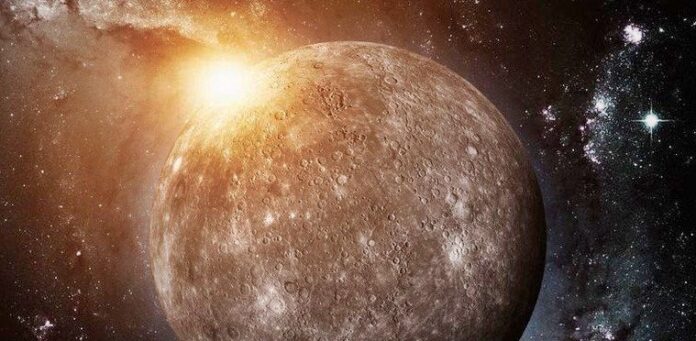In this article, you will find the most interesting facts about Mercury – the planet closest to the Sun, orbiting it at incredible speed. For many of us, the planet Mercury is still relatively unknown and mysterious. Below, discover facts about Mercury that may interest you.
Interesting Facts about Mercury:
- During the day on Mercury, temperatures can exceed 400 degrees Celsius, while at night, temperatures can drop to nearly 100 degrees below zero.
- Mercury has a thin and extremely rare atmosphere consisting mostly of oxygen.
- In the past, there was a theory that Mercury was once a satellite of Venus, but later, due to some catastrophe, it changed its orbit. Now this theory is considered invalid.
- Mercury rotates very slowly on its axis. Approximately every 8 out of 88 days, its orbital speed exceeds its rotational speed.
- From the surface of Mercury, the Sun appears three times larger than from the surface of Earth.
- The largest crater on Mercury’s surface measures about 1525 by 1315 kilometers. It’s called the Caloris Basin, the largest feature on Mercury’s surface.
- Astronomers hypothesize that Mercury has an iron core. It is estimated that eighty percent of the body’s mass belongs to it.
- Since Mercury moves at an angle of no more than 28 degrees from the Sun, it is very difficult to observe. You can only observe the planet in the evening and at a small height above the horizon.
- In many ancient cultures, Mercury was mistakenly considered as two different planets, one observed in the morning and the other in the evening, hence it was given two names instead of one.
- Among all the terrestrial group planets, Mercury remains the least explored planet. Although the least explored planet in the entire solar system is Neptune.
- Another interesting fact about Mercury – according to scientists, on the dark areas of Mercury’s surface, the thickness of water ice reaches 2 meters.
- Longitude ninety degrees east of the solar region. If observers are placed on these edges, they will witness an amazing sight: two sunsets and two sunrises.
- This planet has been subjected to intense bombardment by comets and asteroids for a long time. The bombardment lasted about 1.8 billion years.
- In the meridian 0 and 180, every solar day you can observe three sunsets and three sunrises.
- The lowest point on the planet’s surface is 5.38 kilometers below average. In honor of the great composer, it is named the Rachmaninoff crater.
- There are areas on Mercury that cannot be illuminated by sunlight. Research shows that glaciers exist in these dark areas.
- Mercury can be seen from Earth’s surface shortly after sunrise or sunset. Although Mercury is close to the Sun, it is not the hottest planet in our solar system. This title belongs to its neighbor Venus because an ocean of carbon dioxide and dense clouds create a strong effect on its surface.
- Externally, the surface of the closest planet to the Sun is very similar to the surface of the Moon – the same plains and mountains dotted with impact craters.
- Mercury’s magnetic field is about 100 times weaker than Earth’s but still five times stronger than Mars’.
